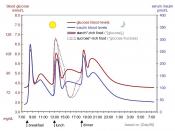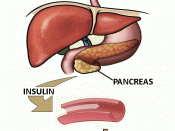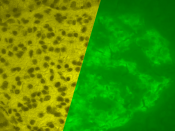Seventy-five years ago the type of diabetes that affected children and young adults was lethal. In the 1990's investigators found that a hormone, that was produced in Islets of Langerhans, was not being produced in diabetes patients. This hormone, called insulin, enables other cells to take up sugar glucose from the blood for energy. Diabetes patients who were not making insulin had glucose from food accumulating in the blood while other tissues were starving. Their are two types of diabetes. Type 1 diabetes has ceased completely from making insulin and the people who had this kind usually died. Type 2 diabetes still makes a little insulin so suffers of this type usually lived.
In the 1920's prospects for people who suffered from type 1 diabetes increased when it was learned that insulin extracted from animals and placed in humans could prevent death. Unfortunately, this is not a cure. Patients can get potentially fatal diabetes-related disorders.
These include blindness and, or kidney failure. Atherososclerosis, numbness and pain in extremities caused by narrowed vessicles, may also be a problem. These effects are caused because insulin injections can't perfectly mimic naturally made insulin.
That's why a therapy that maintains glucose values within normal from the begging is needed. An ideal treatment would be the implantation of islets. This, in theory, would only have to be done once and would insure proper insulin production. Successful grafts would also prevent diabete-related ills.
At Paul E. Lacy's lab, experiments have been done for twenty- five years on such a process. At first they were just trying to understand the mechanics of hormone secretion. To start this they needed a way to separate islet clusters from the pancreas. These constitute only 2% of the entire pancreas, though, and are scattered throughout it. In 1967 they...


